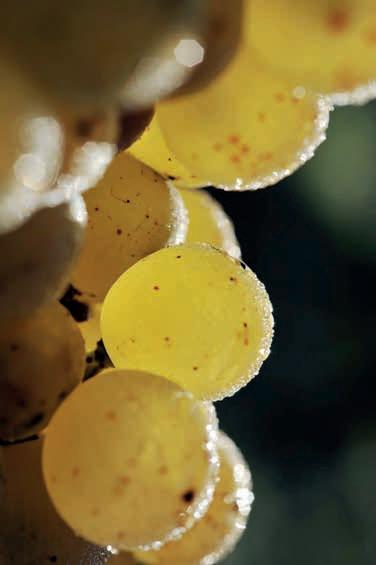
2 minute read
Entre-Deux-Mers Haut-Benauge AOC
Cold fermentation
In Bordeaux all white wines are obtained from green grapes. Unlike red wine we do not want to extract any colour or tannins. It is therefore necessary to avoid any maceration.
During all of the operations, from harvesting to bottling low temperatures and oxidation protection must be controlled so that the grapes can express their full rich aroma.
The first step in making dry white wines consists of scraping the grapes.
Then comes a pre-fermentation low-temperature maceration for a few hours. The grapes are then crushed.
It is an essential stage as a maximum of primary aromas have to be extracted from the skins while limiting phenolic compound extraction. The first clarification is carried out at a low temperature in order to settle the larger particles which could give the wine their heavy and herbal flavour. Clarified must is then removed to separate the clear juice from the lees (deposit), as we carefully maintain sufficient cloudiness to ensure complete fermentation. This operation is called settling.
Alcoholic fermentation then begins with clear juice: it takes place between 18 and 20 C° (to preserve the aromas) and lasts on average for 12 to 15 days. Malolactic fermentation is rarely used in the Bordeaux region because it de-acidifies the wine. Alcoholic fermentation and ageing may be done in tanks or barrels depending on the must’s potential and the type of wine desired.
Maturing on lees then takes place to protect the juice from oxidation, stabilise it and prepare it for healthy in bottle development.
At the end of the maturing stage, the wines are withdrawn; final blending and stabilising operations are carried out (if necessary) before bottling it.
Blending the balance of Bordeaux wines

• The art of marrying parcels and varieties seeking finesse, balance and rich aromas • Expertise handed down from generation to generation • The wine maker or merchant’s signature
Blending is very demanding and constitutes an essential part in Bordeaux wine making. The resulting blended wines are of higher quality than that of the initial wines.
Blending is the art of marrying different grape varieties to obtain a balanced and harmonious ensemble. This expertise is specific to the Bordeaux wine region. Each variety has very specific aromatic and organoleptic characteristics. In most dry white Bordeaux wines, Sauvignon Blanc remains the predominant variety. Tasting of the different batches is the key moment of blending to determine which ones and in which proportions will blend to make up the final wine.
Multiple variety and terroir combinations give a neverending palette of blending possibilities.
Blending is a long process which begins at the beginning of the harvest. The grapes are still on the vines when we have to choose which parcels to combine to ferment them together or in different vats. Then, the two fold selecting and blending approach continues throughout the fermenting and ageing. First in each variety and then between the different ones.








